Preserving Tradition, Protecting the Environment: The Potential of Water Cadastre Systems to Mitigate the Effects of Batik Production on Groundwater and Subsidence in Pekalongan †
Abstract
:1. Introduction
2. Materials and Methods
Methods
3. Results and Discussion
3.1. Batik’s Direct Contribution to Surface Water Pollution and Groundwater Exploitation
3.2. Batik’s Indirect Contribution to Land Subsidence and Coastal Inundation
3.3. The Potential of Water Cadastre Systems to Mitigate the Effects
- Legal and Institutional Framework: Establishing a robust legal framework is essential for the implementation of a water cadastre. This includes defining water rights, responsibilities, and restrictions associated with water use. The framework should align with existing water management policies, such as the EU Water Framework Directive, which emphasises sustainable water management practices [44]. Additionally, the integration of local and national governance structures is crucial to ensure that the cadastre operates effectively across different administrative levels.
- Data Collection and Management: A comprehensive water cadastre requires systematic data collection on various aspects of water resources, including quantity, quality, and usage patterns. This involves utilising modern technologies such as Geographic Information Systems (GISs) and Building Information Modelling (BIM) to create detailed spatial representations of water bodies. Data should be collected from various sources, including remote sensing, hydrological studies, and community reporting, to ensure a holistic understanding of the water landscape (“Climate indicators of changes in hydrological characteristics (a case of the Psyol river basin)”, 2020).
- Stakeholder Engagement and Participation: Engaging stakeholders, including local communities, governmental agencies, and environmental organisations, is vital for the success of a water cadastre. Participatory planning processes can enhance the legitimacy and effectiveness of water management strategies [44]. Stakeholders can provide valuable insights into local water issues and contribute to the development of management practices that are socially acceptable and environmentally sustainable.
- Implementation of Monitoring Systems: To effectively manage water resources, the water cadastre should incorporate monitoring systems that track changes in water levels, quality, and usage over time. This could involve the deployment of sensors and remote sensing technologies to gather real-time data [41,43]. Regular monitoring can help identify trends in groundwater extraction and its impacts on land subsidence, allowing for timely interventions [45].
- Integration with Existing Cadastral Systems: The water cadastre should be integrated with existing land and property cadastre systems to provide a comprehensive view of land and water interactions. This integration can facilitate better decision-making regarding land use and water management, ensuring that both resources are managed sustainably [46]. The use of a Land Administration Domain Model (LADM) can also help standardise data and processes across different jurisdictions.
4. Conclusions
- Groundwater Depletion and Land Subsidence: The study documents a significant decline in groundwater levels over the past 20 years, averaging a decrease of 4 m per year between 2005 and 2015. This reduction is linked to increased land subsidence, with subsidence rates averaging 1–2 cm per year in areas with intensive batik production. This phenomenon has led to severe infrastructure damage and increased flooding risks in Pekalongan.
- Coastal Inundation: Satellite imagery indicates a dramatic shift in coastal conditions from 2003 to 2023, with many areas now experiencing coastal inundation. This change is attributed to saltwater intrusion and accelerated coastal erosion, affecting local ecosystems, agriculture, and socio-economic conditions.
- Water Cadastre Framework: The study proposes the implementation of a water cadastre framework to manage groundwater resources sustainably. This framework includes legal and institutional structures, comprehensive data collection through GIS and remote sensing, stakeholder engagement, and integrated monitoring systems. The Dutch water cadastre model serves as a successful example, demonstrating the benefits of accurate data and stakeholder involvement in managing groundwater extraction and mitigating subsidence.
Author Contributions
Funding
Institutional Review Board Statement
Informed Consent Statement
Data Availability Statement
Acknowledgments
Conflicts of Interest
References
- Surya, R.; Fadlil, A.; Yudhana, A. Identification of Pekalongan batik images using backpropagation method. J. Phys. Conf. Ser. 2019, 1373, 012049. [Google Scholar] [CrossRef]
- Steelyana, E. Batik, a beautiful cultural heritage that preserve culture and supporteconomic development in Indonesia. Binus Bus. Rev. 2012, 3, 116. [Google Scholar] [CrossRef]
- Xiao, M. Innovative applications and market impact of Indonesian batik in modern fashion. Studies in Art and Architecture. Stud. ArtArchit. 2024, 3, 62–66. [Google Scholar] [CrossRef]
- Fadhila, E. Implementation of batik wastewater management policy: A case study of Pekalongan city. J. Ilm. Ilmu Adm. Publik 2023, 13, 825. [Google Scholar] [CrossRef]
- Kamis, A.; Syamwil, R.; Widowati, W.; Fadia, I.; Milannis, A. Weeds as an environmentally friendly alternative dyes. IOP Conf. Ser. Earth Environ. Sci. 2022, 969, 012037. [Google Scholar] [CrossRef]
- Budiyanto, S.; Purnaweni, H.; Sunoko, H.R. Environmental Analysis of The Impacts of Batik Waste Water Polution on The Quality of Dug Well Water in The Batik Industrial Center of Jenggot Pekalongan City. E3S Web Conf. 2018, 31, 09008. [Google Scholar] [CrossRef]
- Levi, P.; Hunga, A.; Sidabalok, H. The venture for clean batik production: Input analysis on natural dyeing in batik micro-collectives in Klaten, Central Java, Indonesia. In Proceedings of the 3rd International Conference on Gender Equality and Ecological Justice, Salatiga, Central Java, Indonesia, 10–11 July 2019. [Google Scholar] [CrossRef]
- Latifah, N.R. Preparation and characterization of adsorbent from natural zeolite mixed chicken feather in degradation of batik waste dyes based green chemistry. J. Kim. Dan Pendidik. Kim. 2021, 6, 362. [Google Scholar] [CrossRef]
- Hati, A.; Putranto, T.; Budihardjo, M. Escalate groundwater potential for acquiring sustainability and resilience in Pekalongan city, Indonesia—A review. E3S Web Conf. 2020, 202, 06007. [Google Scholar] [CrossRef]
- Ismanto, A.; Hadibarata, T.; Widada, S.; Atmodjo, W.; Satriadi, A.; Siagian, H.; Safinatunnajah, N. Heavy metal contamination in the marine environment of Pekalongan, Indonesia: Spatial distribution and hydrodynamic modeling. Environ. Qual. Manag. 2023, 33, 37–46. [Google Scholar] [CrossRef]
- Hariani, D.; Eliza, E.; Pratama, D. Study of creative industry development based on Pekalongan batik culture. In Proceedings of the 1st Workshop on Environmental Science, Society, and Technology (WESTECH) 2018, Medan, Indonesia, 8 December 2018. [Google Scholar] [CrossRef]
- Maninggar, N.; Hudalah, D.; Sutriadi, R.; Firman, T. Low-tech industry, regional innovation system and inter-actor collaboration in Indonesia: The case of the Pekalongan batik industry. Asia Pac. Viewp. 2018, 59, 249–264. [Google Scholar] [CrossRef]
- Masrur, M.; Arwani, A. Work ethic and strategic development of batik Pekalongan Indonesia on islamic business perspective. J. Ekon. Syariah Indones. 2020, 10, 67. [Google Scholar] [CrossRef]
- Marwah, S.; Pratiwi, O.; Ramadhanti, W.; Shania, N. Java north coast women’s contribution to economic and religious dynamics: It is time to be a public knowledge. Kne Soc. Sci. 2023, 8, 519–530. [Google Scholar] [CrossRef]
- Adinugraha, H. Marketing endorsement strategy in batik kampus: Islamic business ethics perspective. Sci. J. Has. Penelit. 2021, 6, 9–21. [Google Scholar] [CrossRef]
- Rukayah, R.S.; Juwono, S.; Susilo, S.E.S.; Puguh, D.R. Post office and traditional city center square as city linkage in java. Environ.-Behav. Proc. J. 2019, 4, 126. [Google Scholar] [CrossRef]
- Handayani, W.; Budi, W.Y.; Rika, P.A. Addressing the Debate on the Eco-Friendliness of Indonesian Batik by Water Footprint Approach. J. Environ. Sci. Sustain. Dev. 2023, 6, 116–131. [Google Scholar] [CrossRef]
- Kristijanto, A.I.; Handayani, W.; Levi, P.A.A. The effectiveness of anaerobic baffled reactor and rotating biological contactor in batik wastewater treatment. Makara J. Technol. 2011, 15, 168172. [Google Scholar] [CrossRef]
- Abidin, H.Z.; Andreas, H.; Gumilar, I.; Fukuda, Y.; Pohan, Y.E.; Deguchı, T. Land subsidence of Jakarta (Indonesia) and its relation with urban development. Nat. Hazards 2011, 59, 1753–1771. [Google Scholar] [CrossRef]
- Li, P.; Wang, G.; Liang, C.; Wang, H.; Li, Z. Insar-derived coastal subsidence reveals new inundation scenarios over the yellow river delta. IEEE J. Sel. Top. Appl. Earth Obs. Remote Sens. 2023, 16, 8431–8441. [Google Scholar] [CrossRef]
- Minderhoud, P.; Coumou, L.; Erban, L.; Middelkoop, H.; Stouthamer, E.; Addink, E. The relation between land use and subsidence in the vietnamese mekong delta. Sci. Total Environ. 2018, 634, 715–726. [Google Scholar] [CrossRef]
- Shirzaei, M.; Bürgmann, R. Global climate change and local land subsidence exacerbate inundation risk to the San Francisco bay area. Sci. Adv. 2018, 4, eaap9234. [Google Scholar] [CrossRef]
- Restrepo-Ángel, J.; Mora-Páez, H.; Díaz, F.; Govorčin, M.; Wdowinski, S.; Giraldo-Londoño, L.; Tosic, M.; Fernández, I.; Paniagua-Arroyave, J.F.; Duque-Trujillo, J.F. Coastal subsidence increases vulnerability to sea level rise over twenty first century in cartagena, caribbean colombia. Sci. Rep. 2021, 11, 18873. [Google Scholar] [CrossRef]
- Reed, A.J.; Mann, M.E.; Emanuel, K.A.; Lin, N.; Horton, B.P.; Kemp, A.C.; Donnelly, J.P. Increased threat of tropical cyclones and coastal flooding to New York City during the anthropogenic era. Proc. Natl. Acad. Sci. USA 2015, 112, 12610–12615. [Google Scholar] [CrossRef] [PubMed]
- Antonellini, M.; Pandolfini, M.; Greggio, N.; Mollema, P. Geothermal characterization of the coastal aquifer near Ravenna (Italy). Acque Sotter.-Ital. J. Groundw. 2012, 1, 19–30. [Google Scholar] [CrossRef]
- Abidin, H.Z.; Andreas, H.; Gumilar, I.; Wangsaatmaja, S.; Fukuda, Y.; Deguchi, T. Land subsidence and groundwater extraction in Bandung Basin, Indonesia. IAHS-AISH Publ. 2009, 329, 145. [Google Scholar]
- Sarah, D.; Soebowo, E.; Sudrajat, Y.; Satriyo, N.A.; Putra, M.H.Z.; Wahyudin. Mapping the environmental impacts from land subsidence hazard in Pekalongan City and its correlation with the subsurface condition. IOP Conf. Ser. Earth Environ. Sci. 2023, 1201, 012044. [Google Scholar] [CrossRef]
- Ouyang, M.; Ito, Y.; Tokunaga, T. Local land subsidence exacerbates inundation hazard to the Kujukuri Plain, Japan. Proc. Int. Assoc. Hydrol. Sci. 2020, 382, 657–661. [Google Scholar] [CrossRef]
- Wibowo, P.; Hartoko, A.; Ambariyanto, A. Land subsidence affects coastal zone vulnerability (pengaruh penurunan tanah terhadap kerentanan wilayah pesisir). Ilmu Kelaut. Indones. J. Mar. Sci. 2015, 20, 127. [Google Scholar] [CrossRef]
- Ward, P.J.; Marfai, M.A.; Yulianto, F.; Hizbaron, D.R.; Aerts, J.C.J.H. Coastal inundation and damage exposure estimation: A case study for Jakarta. Nat. Hazards 2011, 56, 899–916. [Google Scholar] [CrossRef]
- Toshboyeva, R. Issues of further improving the water cadastre legislation of Uzbekistan. Rev. Law Sci. 2021, 5, 71–87. [Google Scholar] [CrossRef]
- Petrakovska, O.; Dubnytska, M. Features of cadastral accounting and monitoring of water facilities in Ukraine. Transf. Innov. Technol. 2018, 1, 26–35. [Google Scholar] [CrossRef]
- Kwartnik-Pruc, A.; Mączyńska, A. Methodology of assessing quality of spatial data describing course of shoreline as tool supporting water resource management process. J. Water Land Dev. 2023, 57, 167–180. [Google Scholar] [CrossRef]
- Navarra, D.; Molen, P. A global perspective on cadastres and geo-ict for sustainable urban governance in view of climate change. Ace Arquit. Ciudad. Y Entorno 2014, 8, 59–72. [Google Scholar] [CrossRef]
- Khilchevskyi, V.; Grebin, V.; Dubniak, S.; Zabokrytska, M.; Bolbot, H. Large and small reservoirs of Ukraine. J. Water Land Dev. 2022, 52, 101–107. [Google Scholar] [CrossRef]
- Jung, J.; Su, X.; Baeza, M.; Hong, S. The effect of organizational culture stemming from national culture towards quality management deployment. TQM J. 2008, 20, 622–635. [Google Scholar] [CrossRef]
- Horan, R.D.; Shortle, J.S. Economic and ecological rules for water quality trading. JAWRA J. Am. Water Resour. Assoc. 2011, 47, 59–69. [Google Scholar] [CrossRef]
- Dey, P.K.; Clegg, B.T.; Bennett, D.J. Managing enterprise resource planning projects. Bus. Process Manag. J. 2010, 16, 282–296. [Google Scholar] [CrossRef]
- Robbins, G.; Mulligan, E.; Keenan, F. E-government in the Irish revenue: The Revenue On-line Service (ROS): A success story? Financ. Account. Manag. 2015, 31, 363–394. [Google Scholar] [CrossRef]
- Herrera-García, G.; Ezquerro, P.; Tomás, R.; Béjar-Pizarro, M.; López-Vinielles, J.; Rossi, M.; Mateos, R.M.; Carreón-Freyre, D.; Lambert, J.; Teatini, P.; et al. Mapping the global threat of land subsidence. Science 2021, 371, 34–36. [Google Scholar] [CrossRef]
- Lin, G.; Gong, H.; Zhu, F.; Zhu, L.; Zhang, Z.; Zhou, C.; Gao, M.; Sun, Y. Analysis of the spatiotemporal variation in land subsidence on the Beijing Plain, China. Remote Sens. 2019, 11, 1170. [Google Scholar] [CrossRef]
- Minderhoud, P.; Middelkoop, H.; Erkens, G.; Stouthamer, E. Groundwater extraction may drown mega-delta: Projections of extraction-induced subsidence and elevation of the Mekong delta for the 21st century. Environ. Res. Commun. 2020, 2, 011005. [Google Scholar] [CrossRef]
- Aichi, M.; Tokunaga, T. Poroelastic modeling to assess the effect of water injection for land subsidence mitigation. Proc. IAHS 2015, 372, 431–435. [Google Scholar] [CrossRef]
- Koontz, T.M.; Newig, J. Cross-level information and influence in mandated participatory planning: Alternative pathways to sustainable water management in Germany’s implementation of the EU water framework directive. Land Use Policy 2014, 38, 594–604. [Google Scholar] [CrossRef]
- Gharehdaghi, M.; Fakher, A.; Cheshomi, A. The combined use of long-term multi-sensor insar analysis and finite element simulation to predict land subsidence. Int. Arch. Photogramm. Remote Sens. Spat. Inf. Sci. 2019, 42, 421–427. [Google Scholar] [CrossRef]
- Rugland, E. Integrating Land Use and Water Management: Planning and Practice; Lincoln Institute of Land Policy: Cambridge, MA, USA, 2022. [Google Scholar]
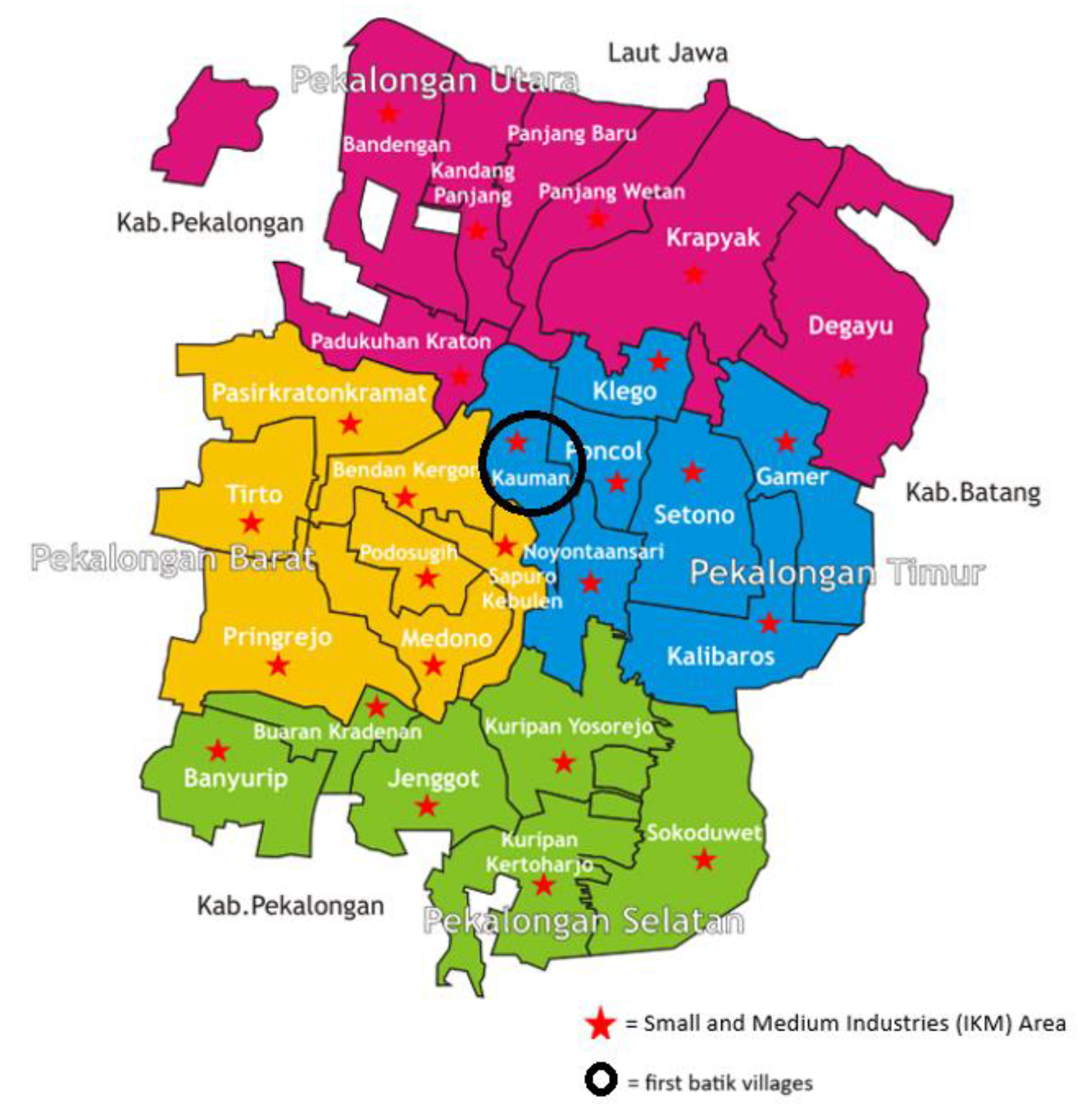
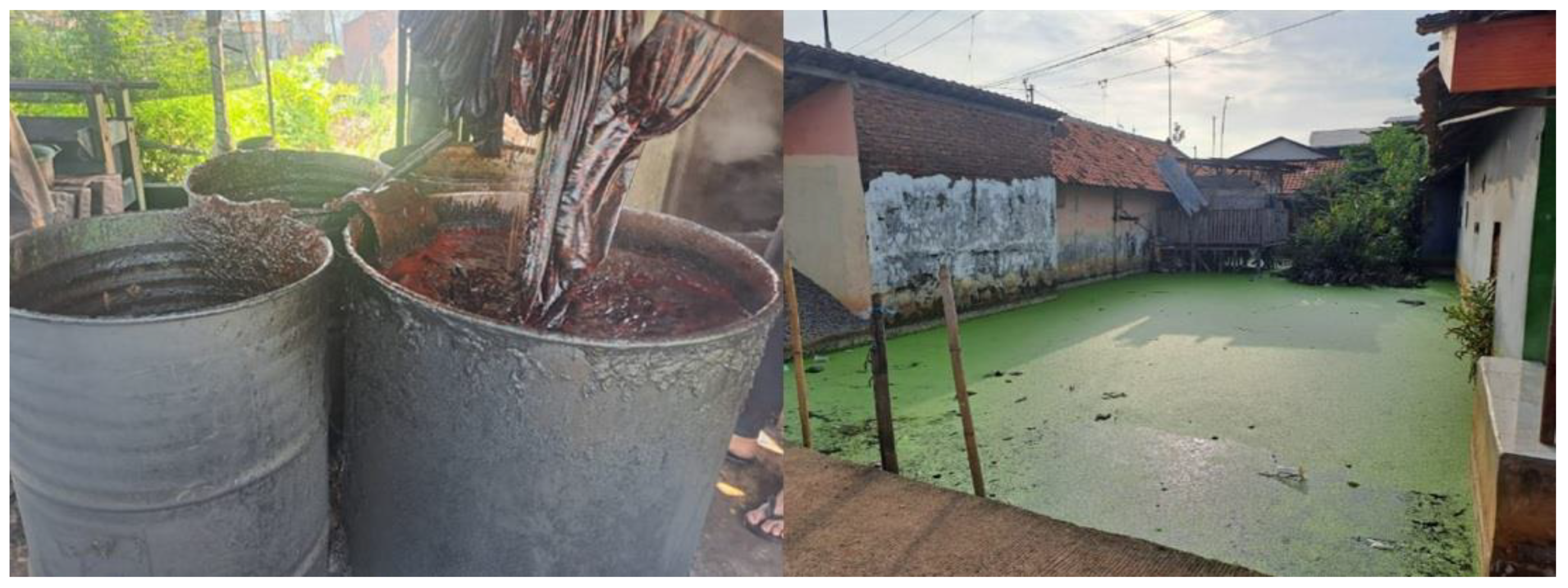
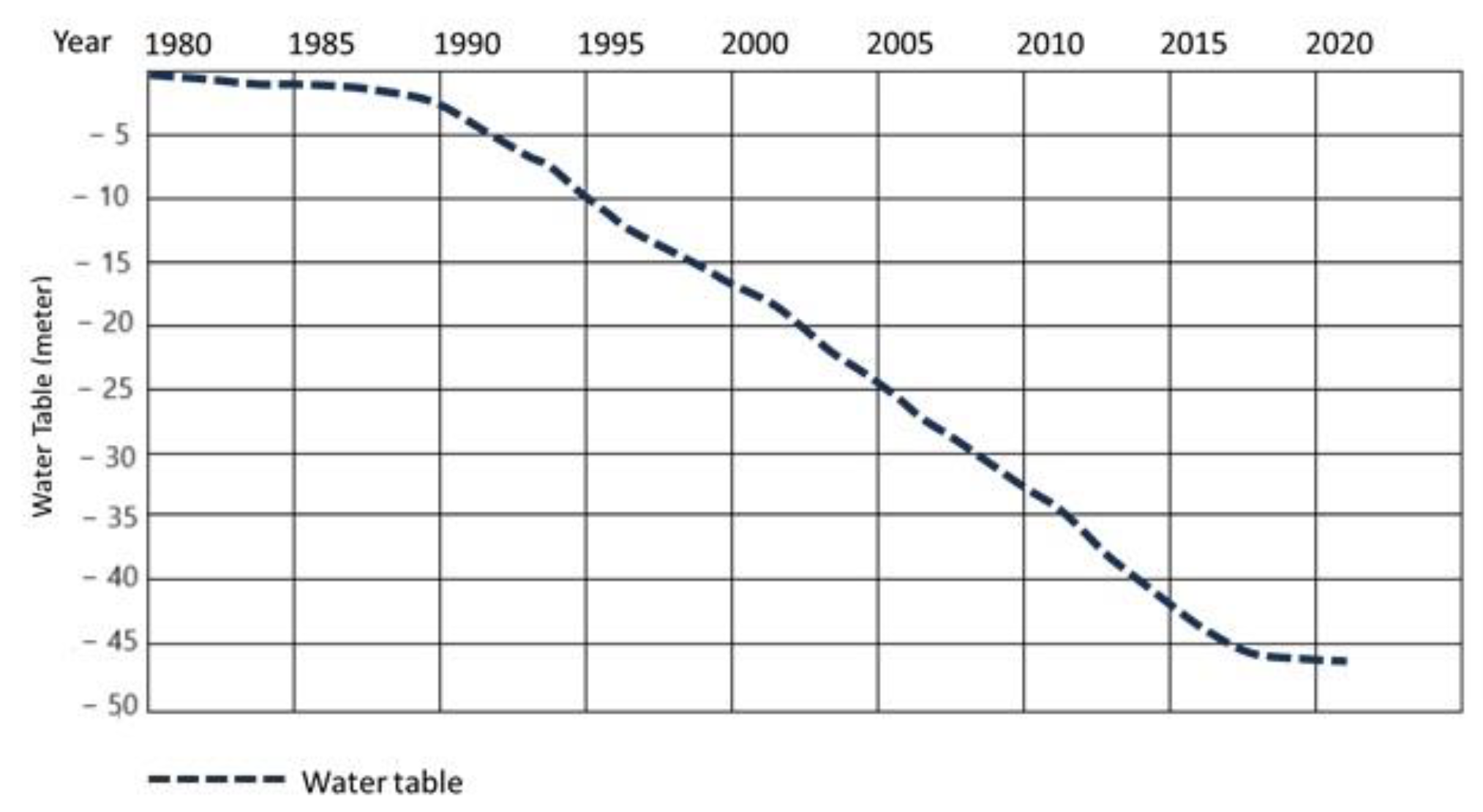
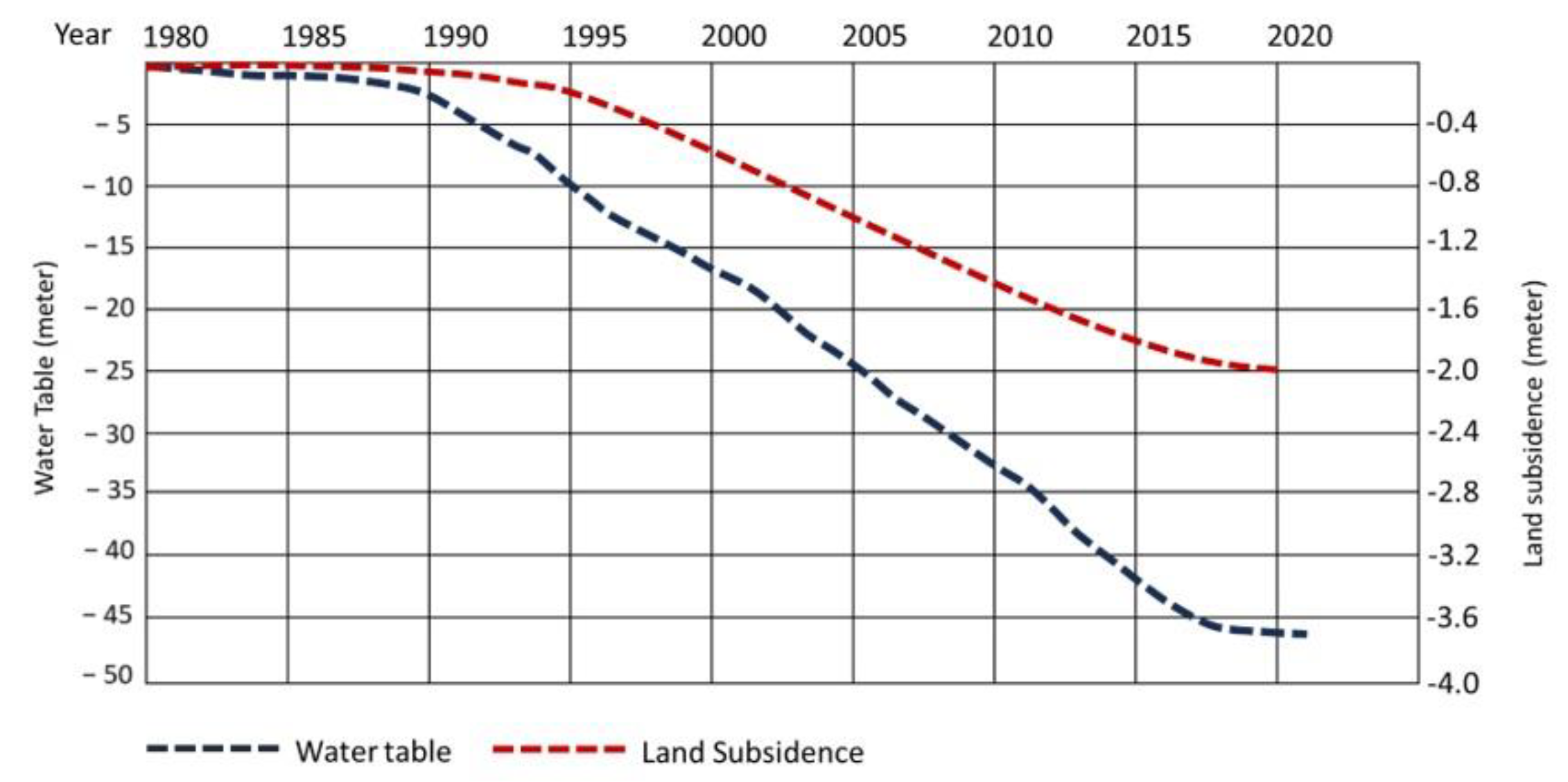


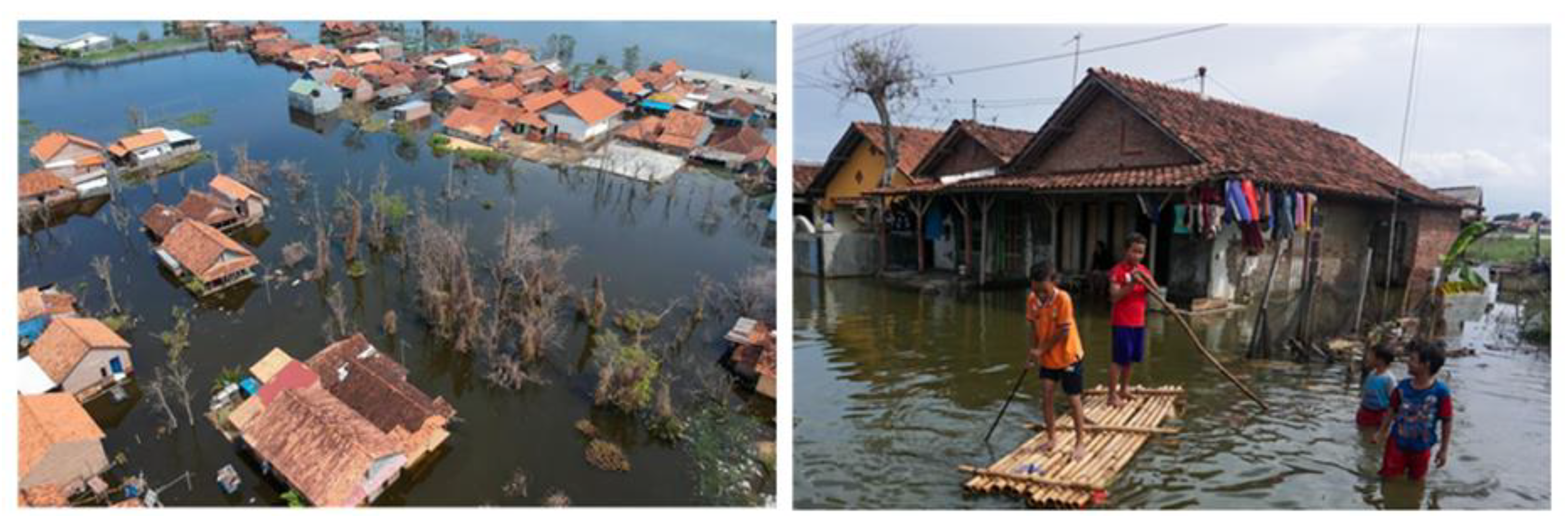
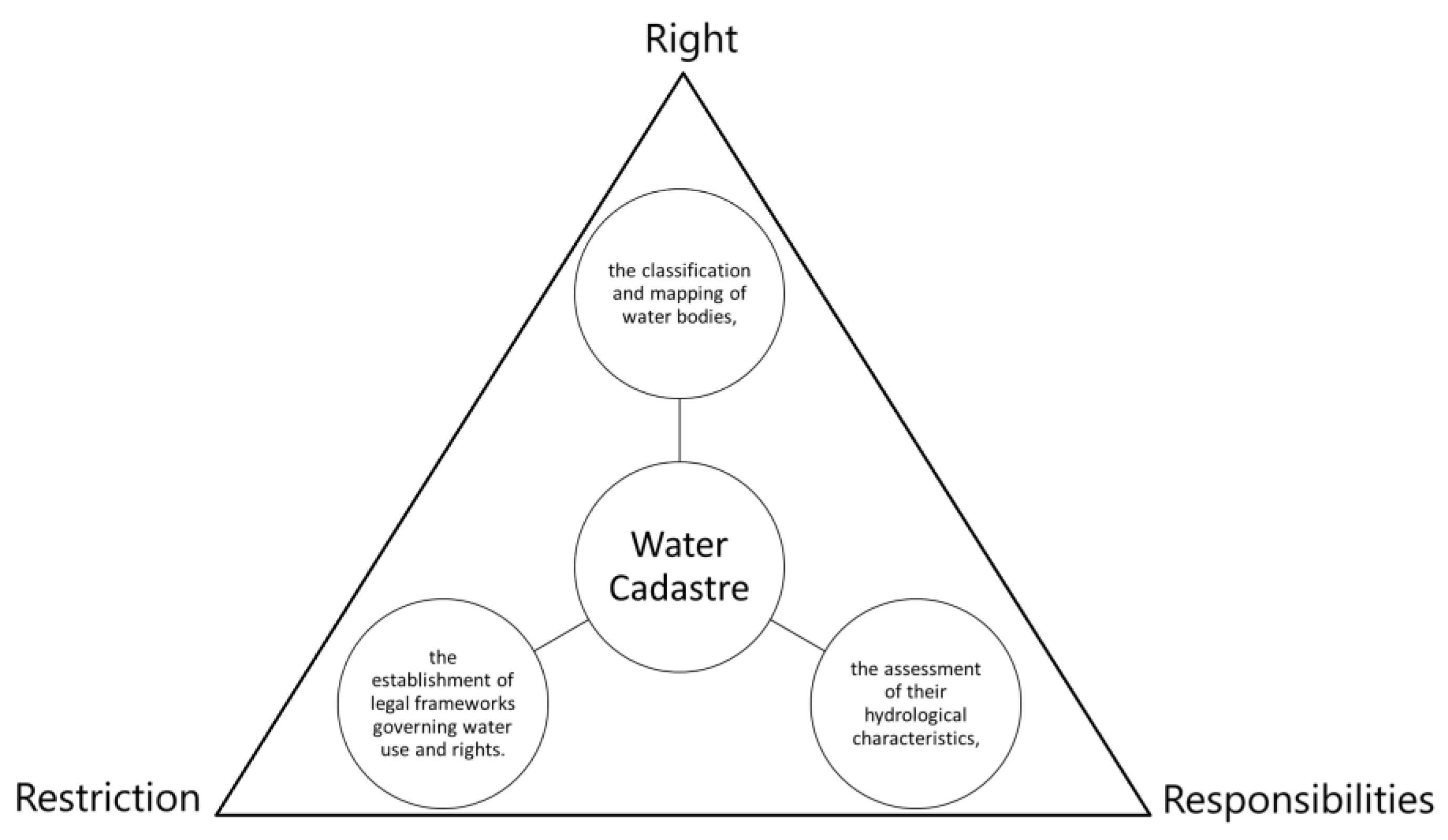
Disclaimer/Publisher’s Note: The statements, opinions and data contained in all publications are solely those of the individual author(s) and contributor(s) and not of MDPI and/or the editor(s). MDPI and/or the editor(s) disclaim responsibility for any injury to people or property resulting from any ideas, methods, instructions or products referred to in the content. |
© 2025 by the authors. Licensee MDPI, Basel, Switzerland. This article is an open access article distributed under the terms and conditions of the Creative Commons Attribution (CC BY) license (https://creativecommons.org/licenses/by/4.0/).
Share and Cite
Handayani, A.P.; Andreas, H.; Pradipta, D. Preserving Tradition, Protecting the Environment: The Potential of Water Cadastre Systems to Mitigate the Effects of Batik Production on Groundwater and Subsidence in Pekalongan. Environ. Earth Sci. Proc. 2025, 33, 8. https://doi.org/10.3390/eesp2025033008
Handayani AP, Andreas H, Pradipta D. Preserving Tradition, Protecting the Environment: The Potential of Water Cadastre Systems to Mitigate the Effects of Batik Production on Groundwater and Subsidence in Pekalongan. Environmental and Earth Sciences Proceedings. 2025; 33(1):8. https://doi.org/10.3390/eesp2025033008
Chicago/Turabian StyleHandayani, Alfita Puspa, Heri Andreas, and Dhota Pradipta. 2025. "Preserving Tradition, Protecting the Environment: The Potential of Water Cadastre Systems to Mitigate the Effects of Batik Production on Groundwater and Subsidence in Pekalongan" Environmental and Earth Sciences Proceedings 33, no. 1: 8. https://doi.org/10.3390/eesp2025033008
APA StyleHandayani, A. P., Andreas, H., & Pradipta, D. (2025). Preserving Tradition, Protecting the Environment: The Potential of Water Cadastre Systems to Mitigate the Effects of Batik Production on Groundwater and Subsidence in Pekalongan. Environmental and Earth Sciences Proceedings, 33(1), 8. https://doi.org/10.3390/eesp2025033008





